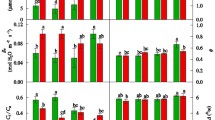Abstract
Leaf carbon isotope ratios (δ13C) and photosynthetic gas exchange were measured on plants growing in hanging garden communities in southern Utah, USA. Hanging gardens are unusual, mesic cliff communities occurring where water seeps from the sandstone bedrock in an otherwise extremely arid region; there is very limited overlap in species distributions inside and outside these gardens. Solar exposure in hanging gardens varied with orientation and one of the gardens (Ribbon Garden) was shaded throughout the day. The leaf δ13C values of plants in hanging gardens were significantly more negative than for plants from either nearby ephemeral wash or riparian communities. In Ribbon Garden, the observed δ13C values were as low as −34.8‰, placing them among the most negative values reported for any terrestrial plant species growing in a natural environment. Hanging garden plants were exposed to normal atmospheric CO2 with an average δ13C value of −7.9‰ and so the low leaf δ13C values could not be attributed to exposure to a CO2 source with low 13C content. There was a seasonal change toward more negative leaf δ13C values at the end of the growing season. The observed leaf δ13C values were consistent with photosynthetic gas exchange measurements that indicated unusually high leaf intercellular CO2 concentrations associated with the relatively low light levels in hanging gardens. Thus, extremely negative leaf δ13C values would be expected if significant amounts of the seasonal carbon gain occur at light levels low enough to be near the light compensation point. Maximum observed photosynthetic rates varied with light levels at each of the gardens, with maximum rates averaging 20.3, 14.6, and 3.1 μmol m−2 s−1 at Double Garden, Lost Garden, and Ribbon Garden, respectively. Leaf nitrogen contents averaged 18.5 mg g−1 in species from the more shaded hanging gardens (Lost and Ribbon). When expressed on a leaf area basis, nitrogen contents averaged 117 mmol N m−2 at Lost Garden and 65 mmol N m−2 at Ribbon Garden (shadiest of the two gardens). Leaf nitrogen isotope ratios averaged −2.3‰ (range of −0.7 to −6.1‰), suggesting that most of the nitrogen was derived from a biological fixation source which is most likely the Nostoc growing on the sandstone walls at the seep. These values contrast with leaf nitrogen isotope ratios of 5–9‰ which have been previously reported for arid zone plants in nearby ecosystems.
Similar content being viewed by others
Author information
Authors and Affiliations
Additional information
Received: 19 January 1997 / Accepted: 19 April 1997
Rights and permissions
About this article
Cite this article
Flanagan, L., Cook, C. & Ehleringer, J. Unusually low carbon isotope ratios in plants from hanging gardens in southern Utah. Oecologia 111, 481–489 (1997). https://doi.org/10.1007/s004420050261
Issue Date:
DOI: https://doi.org/10.1007/s004420050261




